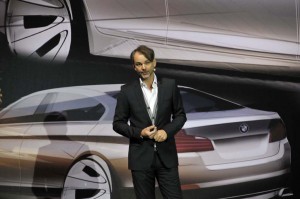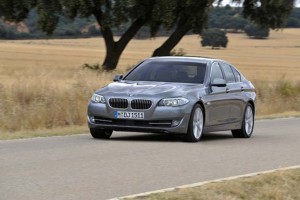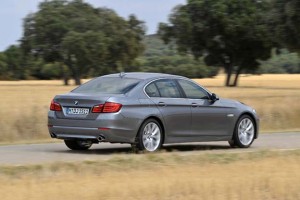The Germans have a way of making the simple sound serious. Officially, the imposing building in the center of Munich is known as the Forschungs- und Innovations Zentrum FIZ of the Group. But Klaus Draeger prefers to just call it “the Project House,” as it’s where some of BMW’s most important projects go from concept to customer.
Like the new 5-Series, which the automaker pulled the wraps off this week, during a formal presentation at the Project House, where Draeger, the BMW board member in charge of R&D, keeps his main office.
First impressions count, said Draeger, admittedly worried about making sure the new car would win over the sceptical media hordes. Introduced in 1972, the 5-Series may not be the Bavarian brand’s biggest seller , but along with the ever-popular 3-Series and the new 1-er, “They account for just over half of our profit margin,” conceded the executive.
The development of the new 5-Series started in 2006 and clearly shows the evolution of the BMW design philosophy that was initiated under former global design director Chris Bangle, who left the company in March, but still left his clear imprint on its new shape.
The exterior was penned by Jacek Fröhlich, who has worked for BMW since 1997. Responsible for the interior is Oliver Heilmer, who also handled the cockpit of the X6. Both designers report to BMW’s chief designer Anders Warming, and, in turn to Bangle’s successor Adrian van Hooydonk.
Both Warming and his two 5 Series designers agree that the transition from Bangle to Van Hooydonk was a seamless procedure. “They worked together for such a long time that they spoke the same language,” said Fröhlich, adding that, “We all do.” When asked, he said it took him about a year after arriving at the BMW design team in 1997, to ‘get’ the BMW feeling.
One of the challenges for the team was to create a more sporty 5 than the current model, a challenging goal considering the latest regulations for pedestrian safety in the European Union. Part of the trick was to work in creases placed right above the highest parts of the hood which, using more flexible aluminium, provided the needed ‘absorbing area’ to soften the blow if a pedestrian landed on the bonnet.

Adrian van Hooydonk took over as BMWs global design director in March. But the 2011 5-Series was strongly influenced by predecessor, the oft-controversial Chris Bangle.
With the somewhat inclined kidney grille, lower than the one on the current 5, the nose looks more sporty and elegant. At the side, the more active impression is enhanced by the sharper Hoffman kink. That’s the angle at the back of the third window, which now runs deeper into the C-pillar than before. New, LED taillights add to the contemporary feel you get when you see the new Bimmer.
Of course, the beauty of the 6th generation of the 5-Series has to be more than skin-deep. Already known for its aggressive road feel, the car’s handling is reportedly improved due to a 50 per cent increase in stiffness – which incidentally added only 33 pounds to the total weight of the car.
The new 5 has a 116.8 inch wheelbase, which yields about a half-inch more rear legroom. That is one aspect of the much-improved interior, with a center console that is somewhat inclined towards the driver, enhancing both the sporty feel and overall elegance of the new 5-Series.
When the 2011 BMW 5-Series hits the markets, worldwide, on March 20th, it will be available as the 550i with the 8-cylinder TwinPower turbo, as the 523i, 528i and 535i with the inline-6 gasoline engines and as the 525d and 530d with the six cylinder diesels. Mid-year the 520d, with the 4-cilinder diesel, will be added to the model range. It will be the first model of the 5-Series to adopt an Auto Start-Stop function – which instantly shuts the engine off when idled, and automatically restarts it when you lift your foot off the brake.
For the flagship 550i, the sedan will get a new 8-speed Steptronic automatic transmission with paddle shifters on the steering wheel. Steptronic will be an option for the other models, which come standard with a 6-speed stick shift.
The engines will be more efficient without losing power. For instance, the 535i, with its TwinPower turbo engine, is as powerful, but more fuel efficient than the outgoing 8-cylinder in the 540. Acceleration is the same, but fuel economy is expected to rise a couple miles a gallon in the U.S. testing cycle.
The same applies for the new diesels: less fuel and less CO2. The new 530d automatic will also be available with BluePerformance Technology, which meets the future EU6-norm.
For the first driving impressions with the new 5 Series we will have to wait until the second half of January.


